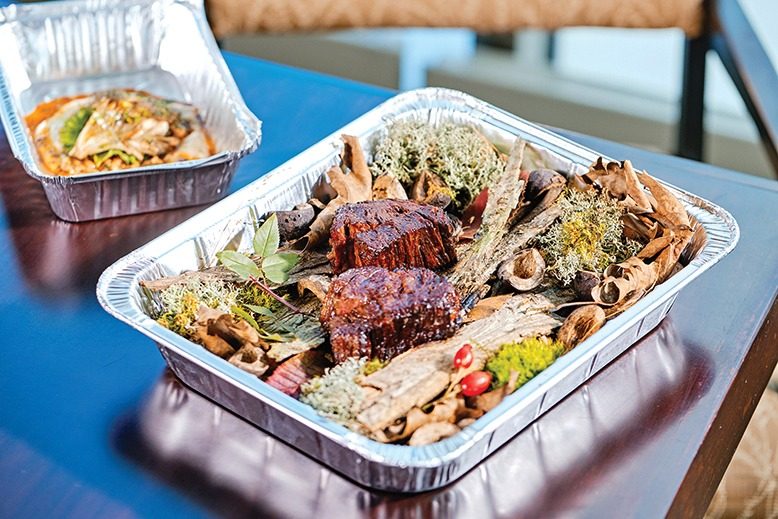
The Windmill hot dog restaurants along the Monmouth County shore have been acing takeout for decades. But takeout in the time of Covid is a different animal. On what used to be a typical summer Saturday, says co-owner Rena Levine Levy, whose family bought the brand in 1976, the now three locations in Long Branch and one in Red Bank would collectively serve a thousand patrons or more. But this year, while business overall is down—largely, Levine Levy says, due to state-mandated early closings—lines remain long.
“Before Covid,” she explains, referring to the large West End Long Branch location, “everybody could have crowded inside. Sometimes we had lines out the door in summer, but now we have them all the time because we’re only allowed a few people in the store at once. We’ve put up a canopy with side panels outside to make the waiting a little more comfortable.”
Pre-Covid, Windmill customers could pump or heap on relish and other condiments to their hearts’ content. Now ketchup, mustard and the rest have to be offered in sealed packets, adding to costs for the restaurant and nowhere near as fun for patrons as pressing a plunger themselves.

Left: Mike Ryan, chef de cuisine of Elements, sautes mushrooms and zests lime over them before assembling an entree of Wagyu beef loin. At right, he spoons cauliflower sauce into a separate container. The sauteed mushrooms will be placed on top. Photos by Ted Nghiem
If takeout has challenged an operation long adept at it, sit-down restaurants, including bastions of fine dining, have had to master a new ballgame. “Not everything travels well,” says Mike Ryan, chef de cuisine of Elements in Princeton, a longtime NJM Top 30 known for its adventurous tasting menus. “Halibut, for instance. It’s delicately textured and can flake apart and get mushy on the trip home. Kampachi [a Hawaiian yellowtail] and tuna work better because they don’t break apart, and salmon is good because its high fat content keeps it moist.”
Early in the pandemic, Ryan and executive chef Scott Anderson offered four- or five-course takeout meals for a modest $49 that aimed to capture some of the adventure of their tasting menus. “But people said it took them two days to finish the meal—which was fine with us,” Ryan says, “because we just want people to be happy; but it worked against us in terms of sales.” When indoor dining resumed in September, to-go petered out until they scrapped the tasting menu and made takeout a la carte.
Ryan and Anderson take pains to minimize the disconnect between the elegant plating onsite and peeling the lid off a foil container at home. An entree of Japanese Wagyu beef loin cooked over strips of aromatic shagbark hickory is nestled on those still-warm strips in the container.
Around the state, chefs who rarely had to do more than plop leftovers into containers have been learning to love the learning curve. “Much of what I used to do doesn’t travel well,” says Kevin Kohler, chef/owner of Cafe Panache in Ramsey. “Sashimi, raw oysters, warm shrimp and avocado with microgreens, which wilts. Anything finessed.”
What does travel well? “Braised meats, like short ribs,” says Anthony Bucco, executive chef of Felina in Ridgewood. “When you send it home with, like, a potato puree, the flavors combine and the transportation actually makes it better.”
In pastas, the heartier the noodles the better. “Garganelli, penne, rigatoni,” Bucco explains, “you put them into a Bolognese and they’re fine. Ravioli is sturdy, you can even reheat it. Squid ink linguini, not so good.”
But this is no exact science. Rosita Lamberti, director of operations of the Aldo Lamberti restaurants in Cherry Hill and Philadelphia, says capellini, whose name translates as angel hair, “has sold very well in takeout.” She adds, “More people have ordered steaks than I would have imagined. If somebody wants a medium steak we suggest they order it medium rare because it will continue to cook in the container. We’ve sold an incredible number of chicken parmigianas, more than ever before. It’s a comfort dish nearly everyone likes; you ate it growing up.”
[RELATED: How 5 Local Chefs Sought Sanity This Year]
Does that description bring anything else to mind? Two syllables, starts with “p”? Yes, pizza has proven itself the ultimate pandemic takeout food. So much so that in October the Farm and Fisherman Tavern, a New American restaurant in Cherry Hill, ripped out one of its convection ovens and a six-burner stove and put in a two-deck pizza oven that can cook eight 16-inch pies at a time.
But there are exceptions. “What people wanted in March, they don’t want now,” says Humberto Campos Jr, chef/owner of Lorena’s, a NJM Top 30 in Maplewood. “I can’t sell chicken for the life of me. People want foie gras.”
One of the most ambitious pivots to takeout was pulled off seamlessly by Stage Left Steak in New Brunswick. For 29 years, it has held winemaker dinners in the restaurant. Last April, proprietors Mark Pascal and Francis Schott turned them into Zoom events, with participants picking up or having par-cooked dishes and bottles of wine delivered for home consumption as they watch the winemakers and chefs expound.
While takeout sounds like a win-win, the cost of containers, bags and supplies, let alone PPE, have squeezed restaurant bottom lines. And there is another hurdle—customers’ fear of physical contact. Says Danny Tran, general manager of Bamboo Village, a well-regarded Chinese restaurant in a Woodland Park strip mall, “Customers won’t even open the door when they pick up. They say, ‘Leave it outside. We’ll pick it up.’”
Marilyn Schlossbach, chef/owner of Pop’s Garage and Langosta Lounge in Asbury Park, weathered Sandy but finds Covid-19 uniquely frustrating. “We’re all trying to shift to takeout,” she says, “but we didn’t get into this industry to send faceless packages in an Uber car. We want to feed people face-to-face.”
